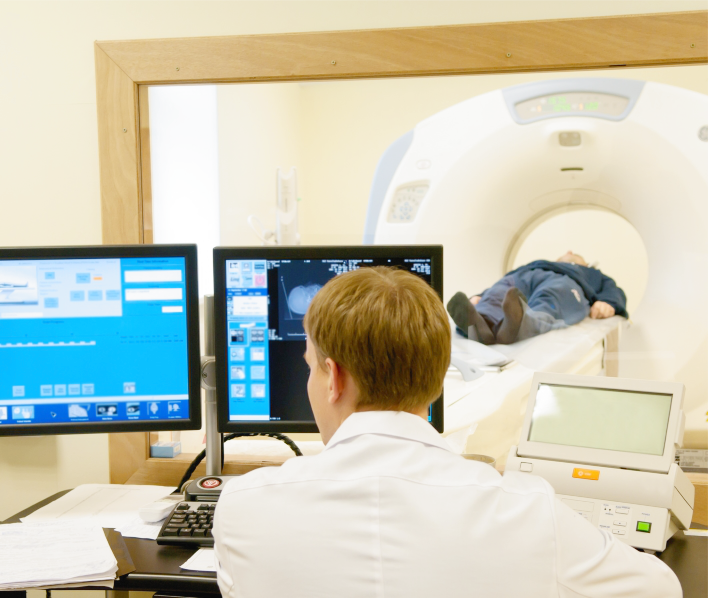COMPUTED TOMOGRAPHY

What is computed tomography?
Computed tomography is one of the most modern and precise medical examination techniques, that enable to obtain precise information on anatomic features of patient’s different body parts, the conditions, and pathologies without conducting an invasive intervention.
What kind of organs it is possible to examine?



This examination is available for patients from 18 years of age.
What is the key principle behind computed tomography technology?
A simple description of the basic principle of the procedure – while the patient is in a special scanning device, the examined areas of the body are irradiated with ionizing (X-ray) radiation, which is then registered by sensors built into the equipment, which send the information received to the data processing unit.
In this data processing unit, images of the irradiated part of the body are formed. During the examination, hundreds of thin cross-sectional images of a certain part of the body are obtained, which are further analyzed and connected by a computer program, creating both two-dimensional and three-dimensional images of various planes. The obtained images are analyzed by the specialist, who is evaluating the deviations and anomalies, to evaluate what is happening in different layers of the projection. Compared to X-ray images, CT scans allow specialists to evaluate whether any pathological changes have affected the soft tissues of the organs. Such an analysis is possible due to the precise fixation of the radiation flux in computed tomography and the processing of the information received in special programs.
The opportunities and benefits offered by computed tomography technology
The latest and the most technologically advanced computed tomography devices can precisely display the appearance and condition of various internal organs of a person. It allows noticing even the slightest changes, making it possible to diagnose diseases and pathologies at an early stage of their development.
In medicine, there are situations when the patient does not have complaints or symptoms that indicate a health risk. In situations like these, computed tomography examinations might help to timely diagnose problems and conditions, and enable the specialists to operatively start the medical treatment process. This is especially important in the case of oncological diseases because then the diagnosis made at the beginning of the disease can save the patient’s life.
The latest multilayer computed tomography devices in terms of diagnostics are equivalent to the direct coronary angiography technology. In comparison with other medical examination methods, computed tomography tests are faster, non-invasive, and don’t cause unpleasant sensations to the patients.
Computed tomography is also useful in diagnosing diseases and pathologies of the spine and joints. Bone tissue is especially visible on CT scans. Unlike an X-ray, the examined zone can be viewed from multiple angles, and the softest tissues will also be visible in the image.
Important information the patient should know
- It is possible to conduct a CT examination only with a doctor’s referral;
- CT examination may require the introduction of a contrast agent into the body – into the gastrointestinal tract or bloodstream (in this case, before the examination, it will be necessary to pass tests to determine the functional state of the kidneys);
- During most of CT examinations the patients are required to have an empty stomach, therefore it is necessary that patient attentively follows the doctor’s provided instructions;
- To avoid low image quality all the accessories from the examination areas must be removed (accessories, watches, etc.);
- The examination is contraindicated for women who are pregnant.
Important information!
- CT examinations are available, which doesn’t require long queuing time.
- For the examination, the patient needs to have the family doctor’s or other specialists’ referral. Conduct a CT test without long waiting in the queue and wasted time! Book the appointment by calling to +371 67799100 or +371 20022581
How is the CT examination process conducted?
The patient is placed on a special surface, which is slowly moving through an arched type of scanner, where the radiography bulb is rotating. The irradiation process requires a short period of time during which the doctor might ask the patient not to move and to hold his or her breath. The total procedure time depends on which part of the body will be examined and the complexity of the imaging and examination process. The duration of the procedure might take between 15 and 30 minutes. In cases, if during the procedure the contrast agent is injected, the patient might feel a sensation of warmth, which is a normal condition and doesn’t indicate side effects or allergy.
Computed tomography is a suitable and forward-looking solution for any patient who wants to obtain effective and accurate information about body condition without invasive intervention. Timely conducted CT examination enables to diagnose possible pathologies in its early development stages, providing fast and effective initiation of the medical treatment process.
